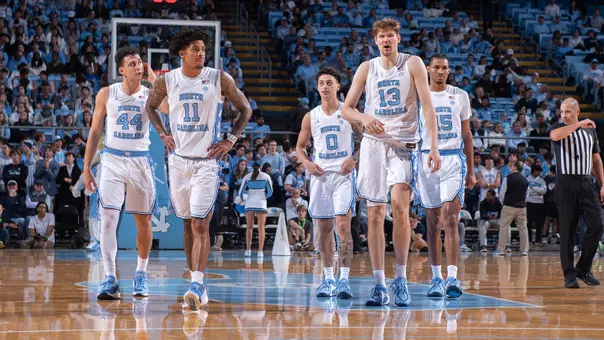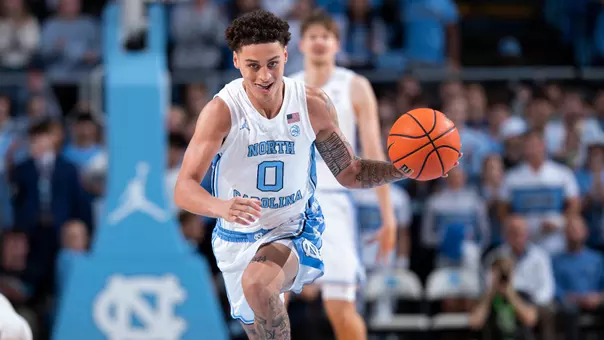University of North Carolina Athletics

Photo by: Maggie Hobson
Lucas: Oh Shoot
February 2, 2021 | Men's Basketball, Featured Writers, Adam Lucas
Carolina struggled in a very basic area at Clemson.
By Adam Lucas
This feels a little like a pop quiz Roy Williams would give clueless freshmen on the first day of practice, but here we go.
What is an extremely important part of the game that needs to happen in order for Carolina to win?
Rebound, yes.
Play good defense, of course.
Play hard, smart and together (someone is looking for extra credit).
All of those are key. But the absolutely essential part of the game that must occur in order to win is this: the Tar Heels have to shoot it. According to James Naismith, you can't put points on the scoreboard if you don't shoot the basketball.
And on Tuesday night at Littlejohn Coliseum, Carolina didn't shoot it nearly enough to win.
The Tar Heels attempted 44 field goals against the Tigers, by far the lowest total of the season and the lowest for a Carolina team since the Heels shot just 43 times in a win over Monmouth in December of 2016. The big difference in that game? Carolina went to the free throw line 46 times. A little over four years later, the Heels show fewer than half that many free throws (21), and we won't even talk about the conversion rate on the charity tosses, because your remote control has probably already suffered enough tonight.
Although Clemson's defense had been more porous in Atlantic Coast Conference play, the Tigers had been one of the nation's best defensive teams earlier in the year. So what exactly happened to prevent the Tar Heels from getting the ball to the rim? Two key factors:
First, Carolina turned the ball over at a disturbing clip. Yes, they had 17 turnovers. But there were just 72 possessions in the game the way that Carolina tracks them, meaning 23.6 percent of the chances with the ball ended in a turnover.
"It's a low possession game," Roy Williams said, "and 17 times we gave it to them without a shot."
For the sake of context, the recent three-game winning streak had seen the following Tar Heel turnover percentages:
Wake Forest: 13.9 percent.
NC State: 14.4 percent.
Pittsburgh: 16.3 percent.
So Carolina wasn't quite twice as careless as they were when they were rolling, but it was close. Caleb Love had four of those turnovers, but it's difficult to pin it on any one Tar Heel, since nine different players were charged with a turnover.
That's one of the two causes of the low shot total, and perhaps the more expected of the two, since Clemson's defense has such a stellar reputation. Less anticipated was the success the Tigers had at keeping Carolina off the offensive glass. The Tar Heels collected just seven offensive rebounds on 27 missed shots. The previous season low had been ten offensive boards.
Carolina entered the game as the second best team in the country in offensive rebounding percentage, while Clemson was just average at preventing opponents from recovering their misses. It seemed like a clear advantage for the Tar Heels.
But it wasn't. Other than Day'Ron Sharpe, who had five, just one other player (Garrison Brooks) had an offensive rebound. The rest had the same total as Wanda.
The breakdowns came as a surprise to Williams, who said his team practiced well the last two days. That is not coachspeak. Monday was a good practice, and the Tar Heels looked every bit like a team rounding into midseason form. You walked away from that session thinking, "This team is figuring it out."
That means Saturday's trip to Duke becomes the ultimate referendum on whether this was simply a one-game anomaly or a true barometer. To beat the Devils, Carolina will have to be tougher defensively than they were on Tuesday night. They'll have to be more effective on the backboards. They'll have to be better in transition.
Oh, and they'll have to shoot.
This feels a little like a pop quiz Roy Williams would give clueless freshmen on the first day of practice, but here we go.
What is an extremely important part of the game that needs to happen in order for Carolina to win?
Rebound, yes.
Play good defense, of course.
Play hard, smart and together (someone is looking for extra credit).
All of those are key. But the absolutely essential part of the game that must occur in order to win is this: the Tar Heels have to shoot it. According to James Naismith, you can't put points on the scoreboard if you don't shoot the basketball.
And on Tuesday night at Littlejohn Coliseum, Carolina didn't shoot it nearly enough to win.
The Tar Heels attempted 44 field goals against the Tigers, by far the lowest total of the season and the lowest for a Carolina team since the Heels shot just 43 times in a win over Monmouth in December of 2016. The big difference in that game? Carolina went to the free throw line 46 times. A little over four years later, the Heels show fewer than half that many free throws (21), and we won't even talk about the conversion rate on the charity tosses, because your remote control has probably already suffered enough tonight.
Although Clemson's defense had been more porous in Atlantic Coast Conference play, the Tigers had been one of the nation's best defensive teams earlier in the year. So what exactly happened to prevent the Tar Heels from getting the ball to the rim? Two key factors:
First, Carolina turned the ball over at a disturbing clip. Yes, they had 17 turnovers. But there were just 72 possessions in the game the way that Carolina tracks them, meaning 23.6 percent of the chances with the ball ended in a turnover.
"It's a low possession game," Roy Williams said, "and 17 times we gave it to them without a shot."
For the sake of context, the recent three-game winning streak had seen the following Tar Heel turnover percentages:
Wake Forest: 13.9 percent.
NC State: 14.4 percent.
Pittsburgh: 16.3 percent.
So Carolina wasn't quite twice as careless as they were when they were rolling, but it was close. Caleb Love had four of those turnovers, but it's difficult to pin it on any one Tar Heel, since nine different players were charged with a turnover.
That's one of the two causes of the low shot total, and perhaps the more expected of the two, since Clemson's defense has such a stellar reputation. Less anticipated was the success the Tigers had at keeping Carolina off the offensive glass. The Tar Heels collected just seven offensive rebounds on 27 missed shots. The previous season low had been ten offensive boards.
Carolina entered the game as the second best team in the country in offensive rebounding percentage, while Clemson was just average at preventing opponents from recovering their misses. It seemed like a clear advantage for the Tar Heels.
But it wasn't. Other than Day'Ron Sharpe, who had five, just one other player (Garrison Brooks) had an offensive rebound. The rest had the same total as Wanda.
The breakdowns came as a surprise to Williams, who said his team practiced well the last two days. That is not coachspeak. Monday was a good practice, and the Tar Heels looked every bit like a team rounding into midseason form. You walked away from that session thinking, "This team is figuring it out."
That means Saturday's trip to Duke becomes the ultimate referendum on whether this was simply a one-game anomaly or a true barometer. To beat the Devils, Carolina will have to be tougher defensively than they were on Tuesday night. They'll have to be more effective on the backboards. They'll have to be better in transition.
Oh, and they'll have to shoot.
Players Mentioned
Carolina Insider - Football vs. Stanford Preview (Full Segment) - November 7, 2025
Friday, November 07
Carolina Insider - Men's Basketball vs. Kansas Preview (Full Segment) - November 7, 2025
Friday, November 07
WBB: Post-Elon Press Conference - Nov. 6, 2025
Friday, November 07
Hubert Davis Pre-Kansas Press Conference
Thursday, November 06




.png&width=36&height=36&type=webp)












